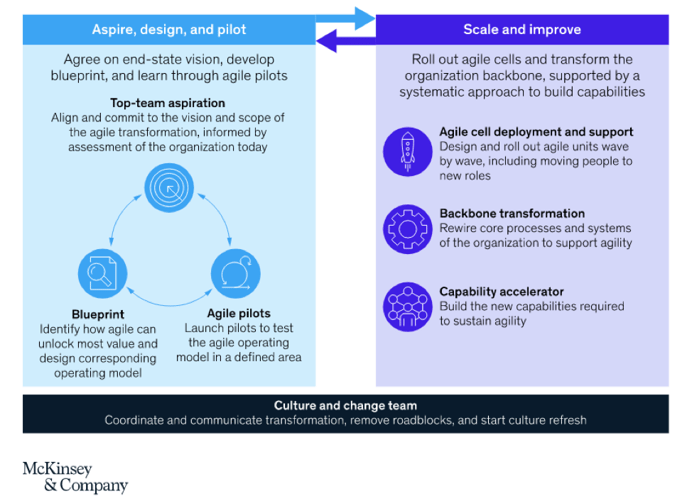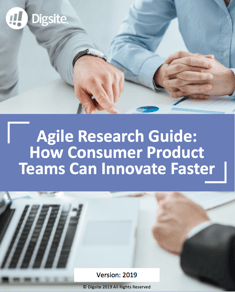Agile organizations enjoy several benefits—like moving quickly, making better decisions, and responding to market changes faster. But what exactly does market research look like in an agile organization?
Main Points:
Organizations are increasingly embracing an agile approach to everything. But one size doesn't fit all. This blog examines what it takes to embrace agile, and how rapid qualitative research plays an important role in agile organizations. Read below to learn:
- Five components for agile transformation
- How iteration is used to foster a test and adapt approach
- The role of agile qualitative research in enabling iteration
In our fast-paced world, new approaches to innovation and research can make the difference between stagnation and success. Today’s leading organizations understand this perfectly, and they’re positioned to quickly respond to evolving markets and environments while leveraging new digital tools to accelerate workflows and help them make better decisions.
Inside these agile organizations, information flows more seamlessly from one person to the next. And because they’re constantly evaluating and evolving to trends and technologies, they’re better positioned to win the war for talent.
Despite these tremendous benefits, some organizations are still more or less traditional. Most decisions are made at the top and employees usually don’t have much opportunity to share input. What’s more, many of these older organizations rely on the same tools and processes that they’ve used forever because that’s the way it’s always been done.
Most modern companies, however, are beginning the transition to an agile organization. A new McKinsey report highlights this growing trend of becoming agile and offers some guidelines organizations should keep in mind as they begin their journey toward a new way of working.
The report also dovetails nicely with what we here at Digsite have been talking about for the last few years: that in order for an organization to truly become agile, rapid qualitative research is needed. But before we jump into why that is, let’s take a step back and briefly examine the cornerstones of the agile organization.
The Five Components of an Agile Transformation
You’ve decided to transition to agile. That’s awesome.
Now the fun starts. As you plan and implement your agile transformation, expect the unexpected and be prepared to revise your plan as new insights emerge. Agile organizations, after all, are able to pivot quickly when new fact patterns or data emerge.
Per the McKinsey report, there are five major components of any organization’s transition to agile:
- Structure. Transforming your business starts with organizational structure. Agile organizations have efficient reporting structures and streamlined decision-making capabilities. They’re powered by thin but nimble teams that move quickly.
- Processes. Agile companies don’t rely on legacy processes they’ve been using forever. They build efficiency into each employee’s workflows by enabling them to remove things like unnecessary meetings so they can spend more time focusing on value-creating tasks. Performance management changes too, as employees are rewarded for the results—not graded against a rubric that’s been set in stone for decades.
- People. An organization is only as strong as the people. Agile organizations understand the benefits of empowering people, which is why they put the best talent in charge and trust them to get the job done—from leadership down to front-line employees. This culture of trust drives innovation by encouraging spontaneous collaboration.
- Technology. Agile organizations are powered by the best tools on the market that help them move quickly and get the most done—all while making informed decisions. They also understand that technology is continuously evolving; even if their tech stack is perfect today, chances are it will look different at some point in the relatively near future. Similarly, DevOps teams and system admins are prepared to make rapid changes because they know it comes with the territory.
- Strategy. Successful changes to structure, people, technology, and processes are tied together by strategy. Without a well-thought-out strategy in place, making significant changes to any area of operations may result in less than desirable outcomes.
Every company is unique, so there’s no tried-and-true blueprint you can follow to become an agile organization. But any successful plan will require close attention to these five components.
As you begin planning your journey toward agility, keep in mind that change doesn’t happen overnight. After you initially implement your plan, you may continuously fine-tune it on your path to becoming a well-oiled organization.
The Iterative Approach That Makes It All Happen
As you begin your transformation, you’ll likely run into some roadblocks. They’re unavoidable—it’s just the nature of change. Iteration lets you can take a test-and-adapt approach, continuously refining your company and approach until everything starts working near as well as you imagined,
This McKinsey illustration sums it up nicely:

No matter how good you think you are doing, there is likely room for further improvement. This is why today’s leading agile organizations never rest on their laurels.
How Agile Research Ties It All Together
At Digsite, we believe that rapid research is in the heart of the agile organization. Without the best data on hand, it’s a lot harder—if not altogether impossible—to make the sound, informed decisions.
Agile research drives product innovation. Successful innovation at that because you’re always drilling down to find out why customers feel a certain way and then adjusting your approach to align with their expectations, making it that much more likely your products and campaigns are best received.
Further, agile research makes it easier to capture the complete customer journey—and therefore optimize experiences along the way. It also improves the customer experience and lets you implement an insight-led strategy that bakes agile into the foundation of every decision your organization makes.
Implementing agile research can help organizations get results faster to accelerate innovation timelines while improving quality.
Now, let’s shift our attention to how, specifically, you can sell the promise of agile research internally.
Making the Case for Agile Research at Your Organization
Data drives decisions. It lets companies know what’s working and what isn’t. It helps companies determine where to invest resources. And it helps organizations know when to pivot.
During any organizational transformation, there are a lot of moving parts. As such, decision-makers might hesitate to think about the importance of insights teams when so many other departments and processes are undergoing reconstruction. But without data, how can anyone expect a massive overhaul to go off without a hitch?
You start by raising the profile of agile research. To do that, you need to socialize its value, demonstrate how simple it is to do, and show everyone how it will make their jobs easier.
Beyond just selling the promise of agile internally, you also need the right set of tools. Platforms like Slack (collaboration), Digsite (agile research), Trello (project management), MURAL (design sprint management), and RealtimeBoard (agile creative development) can help your team move much faster—even when you’re distributed across time zones. Do your due diligence to determine which vendors are best positioned to truly support agile workflows—today and in the future. You’ll make the right choice.
As the above-referenced McKinsey report reveals, the path that leads to becoming an agile organization isn’t always smooth. But with a structured right approach and a commitment to the promise of agile, you’ll get past the bumps in the road. Implement, iterate, and keep improving.
To learn more about how agile research can help your organization get results, check out this case study and download our eBook to find out how agile qualitative research is creating new opportunities for organizations. Finance and CPG organizations may also find our industry specific eBooks helpful to understanding how their peers are using qualitative research to creatively address challenges.





